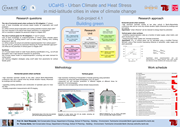Research Module 4.1 Building green
General
Sub-project 4.1 is analysing and quantifying energy and soil water transformation processes of vertical green in an urban environment. Results help to develop strategies against the overheating phenomena of cities. Therefore we are aiming to conduct lysimeter experiments for studying evapotranspiration processes from both vertical green systems and pervious pavements. Our research concept is following two questions: understanding heat and water transport mechanisms at the pavement - atmosphere interface and advection processes controlling daily actual evaporation rates, and secondly analysing plant-atmosphere interactions determining actual and potential evapotranspiration of vertical green facades. Our experimental design also allows quantification of varying water supply on plant water consumption i.e. transpiration rates.
Research Aims
- Analysing daily actual evaporation on partly sealed surfaces with and without influence of advection.
- Analysing daily actual evapotranspiration of growing vertical green with and without influence of advection for various water supply conditions.
- Developing a theoretical approach in order to derive a mathematical formulation (model) for predicting actual and potential evapotranspiration for partly sealed sites.
- Developing a formula for predicting actual and potential evapotranspiration for vertical green plant systems. Starting point is the Penman-Monteith equation.
Collaboration within Research Links (RL)
| 410a | Atmospheric processes, urban/building green and pavements |
Collaboration within Research Cluster (RC)
| 510 | From regional weather and climate to indoor climates |
| 530 | Effectiveness of actions for reducing heat-stress risks |
| 540 | Efficiency of actions for reducing heat-stress risk |
